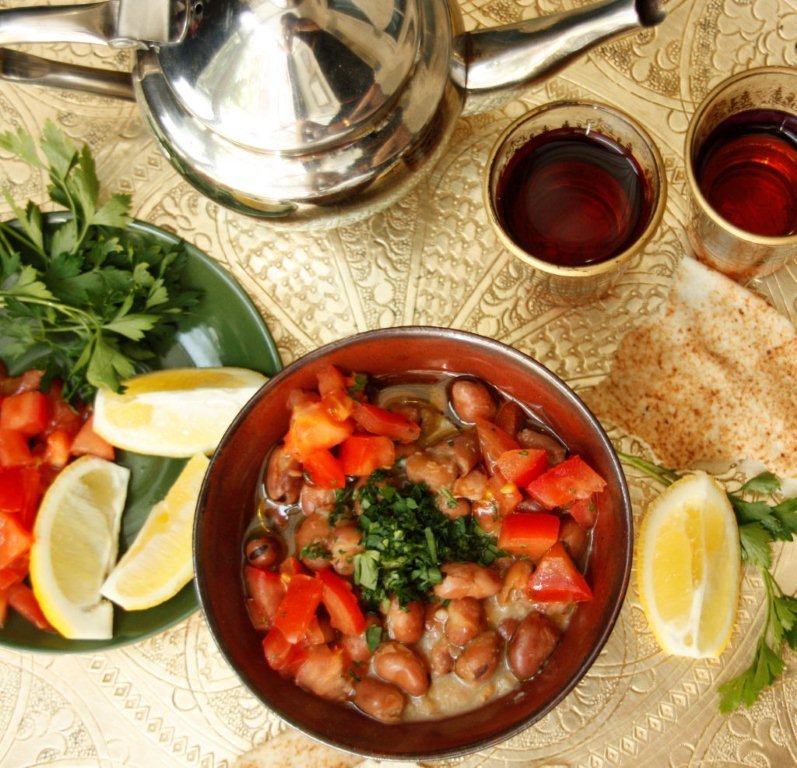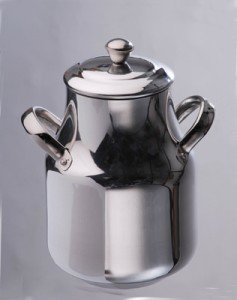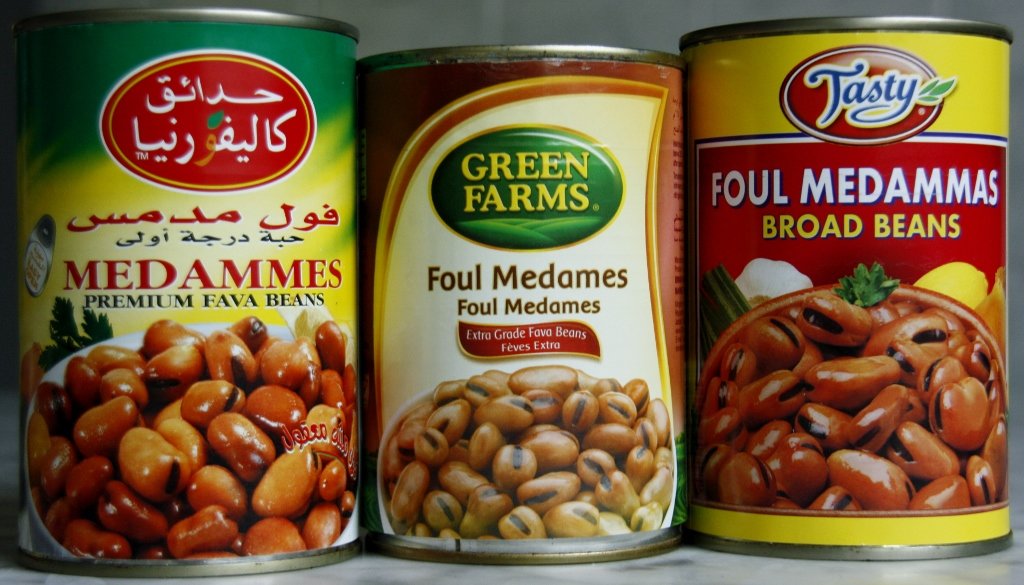Ful for You ~ An Egyptian Breakfast
Ful, a hearty dish made from fava beans, is an everyday food across the Arab World, but is unknown to most Westerners. Ful is most associated with Egypt, which considers it their national dish, typically eaten for breakfast, but also any time of day as a dip, a main dish or sandwich filling.
Some consider ful a “dish of the poor,” but there’s nothing poor about its nutrition or flavor, which is tart, pungent, and earthy, enhanced with lemon and garlic. A peasant dish eaten in the street and the home, ful also appears as a mezze plate in expensive restaurants.
What I love about ful: it’s not only healthy and delicious, but a great dish for those in a hurry, on a budget or who need something filling. It offers a tasty alternative to hummus, which has become a been-there-done-that food.
Egyptians traditionally cook fava beans for hours over a low flame in an idra, a special pot which tapers to a narrow neck. Egyptian street vendors prepare and serve ful in this way.
However, it seems most home cooks today prepare ful in a saucepan on the stove. Some even use a microwave. When I first saw my Palestinian husband’s family make ful, they heated it over a flame right in the can, cowboy-style. I do not recommend this method.
The variations for ful are endless. Fava beans can be puréed, mashed or left with the beans intact. The seasonings vary widely from cumin to paprika and chili powder. Those who like a kick will add cayenne pepper or finely diced hot chilies. Lebanese and Palestinians often add chick peas.
The standard garnishes are olive oil, tomatoes and fresh parsley. Additional toppings on the side can include: chopped onions, fresh mint, radishes, tahini, or hard-cooked eggs. There is no one right way to make this dish.
Fava Beans
Fava beans, also known as broad beans, are a staple in much of the world. The beans come encased in long fat green pods. Fava beans vary in size from ½ inch to a full inch. The large greenish beans require longer soaking and cooking and need to have their skins removed. What we are concerned with here are the small brown beans, the ones commonly used for this dish. The beans are labeled in a variety of ways.
Below is my recipe for Ful Medammes, the most common and basic way to serve ful. Some cooks will want to soak dried beans overnight while spontaneous cooks will prefer to open a can. I have included directions for both. Proportions are not precise; cook according to your taste and preference.
FUL MEDAMMES
Serves 4 as a side dish
1 can (14 oz. / 450 g) fava beans (ful medammes) or 1 cup small dried fava beans
1 teaspoon baking soda (for dried beans only)
2 cloves garlic, pressed
½ teaspoon cumin
juice from 1 lemon
salt
1 tomato, chopped
olive oil
¼ cup fresh parsley, finely chopped
Method
- Prepare the beans. For dried fava beans: sort and soak overnight in 3 cups water with baking soda. The next day, rinse and cover with fresh un-salted water in large saucepan. Cover and simmer gently about 1 hour or until beans are soft enough to mash. Stir occasionally and add more water if necessary. For canned fava beans: heat the can of beans (including liquid) gently in large saucepan until boiling. Simmer on low for 10 minutes to heat through. (Alternatively, heat beans in microwave.)
- In a small bowl, mix the pressed garlic with the cumin, lemon juice, and salt (½ t salt with canned beans, more for dried).
- Remove the fava beans with a slotted spoon and transfer to mixing bowl. Partially mash the bean mixture with fork or pestle, leaving some or most beans intact. Add the lemon juice mixture and gently stir in. Add more cooking liquid if necessary, keeping the beans wet but not soupy. Taste and add more salt or lemon juice if necessary.
- Transfer the ful to a shallow serving dish. Top with chopped tomatoes and a generous drizzle of olive oil. Finish with the chopped parsley.
- Serve warm or at room temperature with sweet tea and fresh Arabic bread. Optional additions on the side: extra lemon wedges, chopped onion, sliced cucumber, chopped green pepper, fresh mint, crumbled feta cheese and/or one hard-cooked egg for each person.






 Follow
Follow
In Sudan there is a yummy version called ‘Bosch’ with sauted onions and ‘taamiya’ -the Sudanese/Egyptian falafel added..plus chopped arugula leaves. Like you said, so many ways to make it…
@Zvezdana Thanks for sharing that, Zvezdana. I think the sauteed onions would be a nice touch. Seems there are endless additions for this humble dish.
Holly, I am simply thrilled to have found your blog today! I will definitely be trying your recipe for foul. It looks wonderful. I prefer the dry beans, and actually make them in the slow cooker overnight (quick-soaking them in boiling water for an hour right in the cooker) for the next morning’s breakfast. Not traditional, but it works! I also am married to a Palestinian, and am eager to read more of what you have to say about raising your family among the two cultures and languages. Thank you for sharing your stories!
@Lara I’m so glad you found your way to my blog. Thank you for the kind comment. It means a lot …. BTW, I actually tried to make ful in the slow cooker the other day. I wasn’t successful (needed more water). But I will try again. Cooking is one long experiment. 🙂 Hope you stop by again. More recipes coming soon. Thanks again!
Hi Holly! This week in our organic box a friend of mine and I are getting fresh Fava Beans… How would we cook fresh fava beans for this recipe? There won’t be any “juice” from a can… would water work? Thanks!
Hi Molly, sounds yummy. I have never prepared fresh fava beans but I’m hearing more & more about them. You’ll need to remove the skins, which is a little time consuming. I suggest you look at different recipes because my ful recipe is specifically for the little brown ful beans. Here is an informative piece from NPR to get you started. Pleae tell me how it goes! http://www.npr.org/templates/story/story.php?storyId=9163283
@Holly S. Warah
Thanks! I’ll keep you posted… We just got the box this morning. They look like giant green beans… 🙂
My brother is coming to visit me in London tomorrow so I’m preparing this as a special breakfast for him. Just started soaking the beans, excited to see how it turns out. Thanks for posting the recipe 🙂
I am also married to a Palestinian man. Although we have so many similar dishes, I am often looking for authentic Arabic recipes. I am so glad I found your blog. My husband often makes ful for our weekend breakfast. We love it. I am going to try your Qataif and Kunafa Nabulisi recipes during Ramadan. Thank you for sharing your recipes and instructions. Keep them coming…
HI Ilknur, Thank you so much for your comment & thank you for reading. I hope the recipes don’t disappoint. Wishing you a Ramadan Kareem.
Holly, I’ve just read your short story……it’s lovely…..I wanted more. I wanted to know what happened to everyone.
Thank you, Becky, for reading & commenting. Your words mean a lot.
Thanks for the recipe i love ful. Iwill try your recipe this weekend.
Thanks
HI Salma, Thanks for stopping by. I hope the recipe worked out for you.
Hi, Holly,
I made your ful mdammas tonight. Although I added more lemon juice and mixed chick peas with fava beans, the outcome was delicious! Thanks for posting such lovely recipes and blog posts. I’ll be back, for sure.
HI Stephanie, A good cook always makes adjustments to suit her taste! So glad it worked out for you. Thanks for stopping by. 🙂
This is AMAZING and omg so cheap to make where I live!!! So much thanks from a broke university student!
Hi Myrcella,
So glad the recipe works for you. Enjoy!
Greetings Holly.
Glad I ran across your blog, after doing a search for … Sudaneese Fava bean breakfast I think it was.
Anyway, I had a Sudaneese/Egyptian friend way back when I was first in college and they used to make this great breakfast for us and of course I had to know too, because it was so amazing. Needless to say, I made it off and on for years, but for some reason I haven’t in many years now(got sidetracked I guess, lol) but I have been intending on making it for some time now, thanks for inspiring me! After reading your blog I made myself this great breakfast once again per your suggestions cause it sounded good too, but slightly different than my friend used to make, as you noted, it has endless variations. I didn’t have any tomatoes today, so I garnished with chopped onion and parsley, mixed together and served over the top and it was equally as deliscious. I don’t remember using lemon juice however, but I tried it since you mentioned it, and its good as well. The main difference was we would use clarified butter, instead of olive oil, which I did today (and made our own, very easy, just melt the butter and spoon out or strain out the curdled white clumpy stuff, which is the fat. What is left is clarified butter 🙂 ) or you can buy it already pre-made in an Indian or Arabic grocery. it does not need refrigeration once it is clarified. Then we would add the spices to that, heat it and pour it over the heated beans which we would serve in a community dish (large enough for three of us to eat from) Then we would then top it with chopped onion and tomato and serve with crusty, heated, all natural, old world style bread. We each got a chunk of that and would tear off pieces to dip in and scoop up the bean mixture and boy, was that heaven! Not only is this dish deliscious and healthy, but eating it in this way (in a community dish) fosters intimate relationships and fond memories with those close to you. No wonder so many foreigners are so family oriented and tight knit, activities such as this helps maintain those bonds, which sadly, most Eurpoeans and Americans have forgotten or lost, due to many reasons of course, but mainly cause we are such a mobile society, that many don’t even live around their families anymore and also we eat far far too much pre packaged, prepared, and chemically laden food, which is so bad for us. Most women work these days and people are too tired, exhausted and stressed out to cook, and many have never even learned how. I find it sad how many modern day American women barely know how to cook anymore and especially not healthy things, but that is slowly changing and more and more are trying to eat healthy again. Thanks again and try it with clarified butter sometime, at least for breakfast, its even better 🙂
Tera,
Thanks so much for reading & for your wonderfully detailed comment. I appreciate your description of how to make Sudanese ful & your comments on the cultural aspects of communal eating. I agree, it’s worth the effort to make healthy family meals. Thank you for stopping by. All the best to you.
HI Tera, Thanks so much for reading & for the lovely comment. I agree, we can learn a lot from the Arab style of meals. And we need to take more time to prepare meals & enjoy them with your families. I will try the clarified butter next time! All the best to you & Happy Eating. 🙂
I am really interested in where I might get a ful pot. Do you have a website that you got the one pictured on your page from?
Hi Tyler,
I think your best bet is looking for one online, say on Ebay. Good luck.